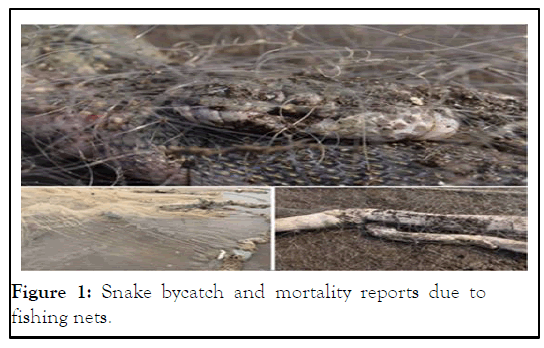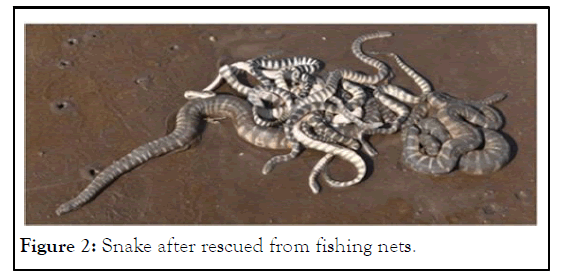Entomology, Ornithology & Herpetology: Current Research
Open Access
ISSN: 2161-0983
ISSN: 2161-0983
Short Communication - (2023)Volume 12, Issue 6
Marine debris such as nets poses serious consequences for wildlife, habitat and human safety. Threats to the persistence of species are typically mitigated through costly and time consuming retrieval strategic planning that is incorporated only after the species is on the brink of extinction. A constructive and take a holistic approach is needed to minimize overall threats and avoid risk to species that are not yet endangered. Nets pose a major risk to aquatic biota because they entrap creatures for as long as they are present in the environment. Numerous aquatic species have been known to be affected and/or killed by plastic debris, which could adversely impact their survival, especially since many are already threatened by other forms of anthropogenic activity. Attention to marine biodiversity is also urgently required if a stable relationship between humans and the sea is to be maintained.
Fishing net hazard; Plastic net waste; Entanglement hazard; Monofilament threats; Bycatch threats
A variety of light weight, inexpensive monofilament netting made of polypropylene or polyethylene plastic has widely available in recent decades in which many of these have proven to be harmful to animal when used in wildlife habitat and basically in aquatic (marine) environment [1-4]. Plastic pollution is considered "poorly reversible" in environment as natural mineralization processes occurring are slow and engineered remediation solutions are unlikely. Plastic waste and its longterm consequences have managed to gain public attention as a worldwide sustainability issue. Plastics threat to the marine environment has long been neglected and its load has only recently been acknowledged [5-8]. These materials often marketed as “fishing net” comes in variety square or rectangular size. Although plastic netting has been reported as an entanglement hazard to birds, as well as many marine species and many cases of net-trapped snakes occur regularly in India [9,10]. Increased use of biodegradable plastics cannot address the issue of plastic pollution. Their lifespans are relatively long and difficult to predict and they are not ordinarily recyclable. Nets and lines could also amputate appendages, limiting an animal's mobility significantly.
During our field study at about 1630 h on 5th April 2022 along a costal mudflat near Kundi, Gujarat, India (20°39'58.9"N 72°58'01.7"E) we found a number of sea snakes trapped on fishing net and died (Figure1). After covering few distances we found few sea snakes were trapped in fishing net i.e., Malacca sea snake (Hydrophis caerulescens), annulated sea snake (Hydrophis cyanocinctus), yellow-bellied sea snake (Hydrophis platurus), short sea snake (Hydrophis curtus) and an adultfile sea snake (Acrochordus granulatus) were heavily entangled in the fishing net. With help of local communities, we able to remove all the alive sea snakes caught through bycatch and released them back to sea (Figure 2).

Figure 1: Snake bycatch and mortality reports due to fishing nets.

Figure 2: Snake after rescued from fishing nets.
Fishing net exclude animals have been implicated in trapping other wildlife as well noted the difficulty in recovering animals from this net which made of woven fine-line monofilament strands. Apart these many other cases are reported in India. Data from the literature clearly mentioned that the fishing net as a threat to not only snake but also many other reptiles like Indian Gharial, Mugger Crocodile [11-14].
A successful marine pollution prevention initiative is built on education and outreach programmes, strong laws and policies and governmental and private regulation. The plastics industry must also enlighten its employees and customers while looking for technological mitigation strategies. To prevent these threats, need to aware fishermen about the repercussions of using and discarding fishnets and how to safely dispose of them. Bycatch of sea snakes due to plastic entanglement causes death to many sea snakes which ultimately declines their population. A thorough understanding of both marine debris and human behaviour is required for effective problem management. With the right incentives, industry could be persuaded to use plastic "waste" as raw material instead of virgin material, which is nowadays invariably lower in price. Individual actions could really help advance transformational movements, but policy measures have the greatest impact on a large scale.
We are thankful to VSPCA, Gujarat for their efforts for coastal ecosystem. We thank Earth Crusaders Organization for literature citation.
The authors declare no conflict of interest during the preparation of this article.
Citation: Patel A, Samal A, Sahu JS, Pattnaik B, Pandey S (2022) Threat to Sea Snakes from Bycatch through Imperilled Fishing Nets Utilization, Report on Rescue of Sea Snakes from Bycatch at Kundi, Gujarat. Entomol Ornithol Herpetol. 11:294.
Received: 13-Nov-2023, Manuscript No. EOHCR-22-18564; Editor assigned: 15-Nov-2023, Pre QC No. EOHCR-22-18564(PQ); Reviewed: 29-Nov-2023, QC No. EOHCR-22-18564; Revised: 06-Nov-2023, Manuscript No. EOHCR-22-18564(R); Accepted: 13-Nov-2023 Published: 14-Nov-2022 , DOI: 10.35248/2161-0983.22.11.294
Copyright: © 2022 Patel A, et al. This is an open-access article distributed under the terms of the Creative Commons Attribution License, which permits unrestricted use, distribution, and reproduction in any medium, provided the original author and source are credited.